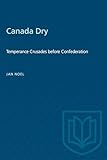Canada Dry : Temperance Crusades before Confederation / Jan Noel.
Material type: TextSeries: HeritagePublisher: Toronto : University of Toronto Press, [1995]Copyright date: ©1995Description: 1 online resource (336 p.)Content type:
TextSeries: HeritagePublisher: Toronto : University of Toronto Press, [1995]Copyright date: ©1995Description: 1 online resource (336 p.)Content type: - 9780802069764
- 9781487578565
- 363.4/1/0971 20
- HV5306 .N63 1995eb
- online - DeGruyter
| Item type | Current library | Call number | URL | Status | Notes | Barcode | |
|---|---|---|---|---|---|---|---|
 eBook
eBook
|
Biblioteca "Angelicum" Pont. Univ. S.Tommaso d'Aquino Nuvola online | online - DeGruyter (Browse shelf(Opens below)) | Online access | Not for loan (Accesso limitato) | Accesso per gli utenti autorizzati / Access for authorized users | (dgr)9781487578565 |
Browsing Biblioteca "Angelicum" Pont. Univ. S.Tommaso d'Aquino shelves, Shelving location: Nuvola online Close shelf browser (Hides shelf browser)

|

|

|

|

|

|

|
||
| online - DeGruyter Behind the Jester's Mask : Canadian Editorial Cartoons About Dominant and Minority Groups 1960-1979 / | online - DeGruyter Patrons, Clients, Brokers : Ontario Society and Politics, 1791-1896 / | online - DeGruyter General Preface and Life of Dr John North / | online - DeGruyter Canada Dry : Temperance Crusades before Confederation / | online - DeGruyter My Orchestras and Other Adventures : The Memoirs of Boyd Neel / | online - DeGruyter Wool, Cloth, and Gold : The Struggle for Bullion in Anglo-Burgundian Trade 1340-1478 / | online - DeGruyter Our Living Tradition : Fourth Series / |
restricted access online access with authorization star
http://purl.org/coar/access_right/c_16ec
The Temperance movement has played a large part in the history of Canada. From the founding of the first known temperance society in 1822 until the passage or near passage of prohibition laws in New Brunswick, Nova Scotia, and the province of Canada in 1855, over half a million colonists took the abstinence pledge. This overview by Jan Noel is the first major study of the subject since Prohibition in Canada by Ruth Spence, published in 1919. Whereas Spence's book was the work of a dedicated prohibition warrior, Noel's study is social history examining the forces that created the temperance movement and the effect of the movement on work, women, children, religion, and social structure. Noel perceives the call for temperance as a hybrid of idealism and material concerns. She assesses the interplay of these concerns in the regions of British North America where the movement showed strength before Confederation: the Atlantic colonies of Newfoundland, New Brunswick, Nova Scotia, and Prince Edward Island; the province of Canada (the southern areas of today's Quebec and Ontario); and the Red River colony. The temperance movement worked. It eliminated the acceptance of drink in the workplace and reduced the amount of alcohol consumed. It throve best and longest where improved communications and a middle class grew. And in conjunction with the broader social-reform agenda of the day, it remade the manners and morals of British North America.
Mode of access: Internet via World Wide Web.
In English.
Description based on online resource; title from PDF title page (publisher's Web site, viewed 01. Nov 2023)


